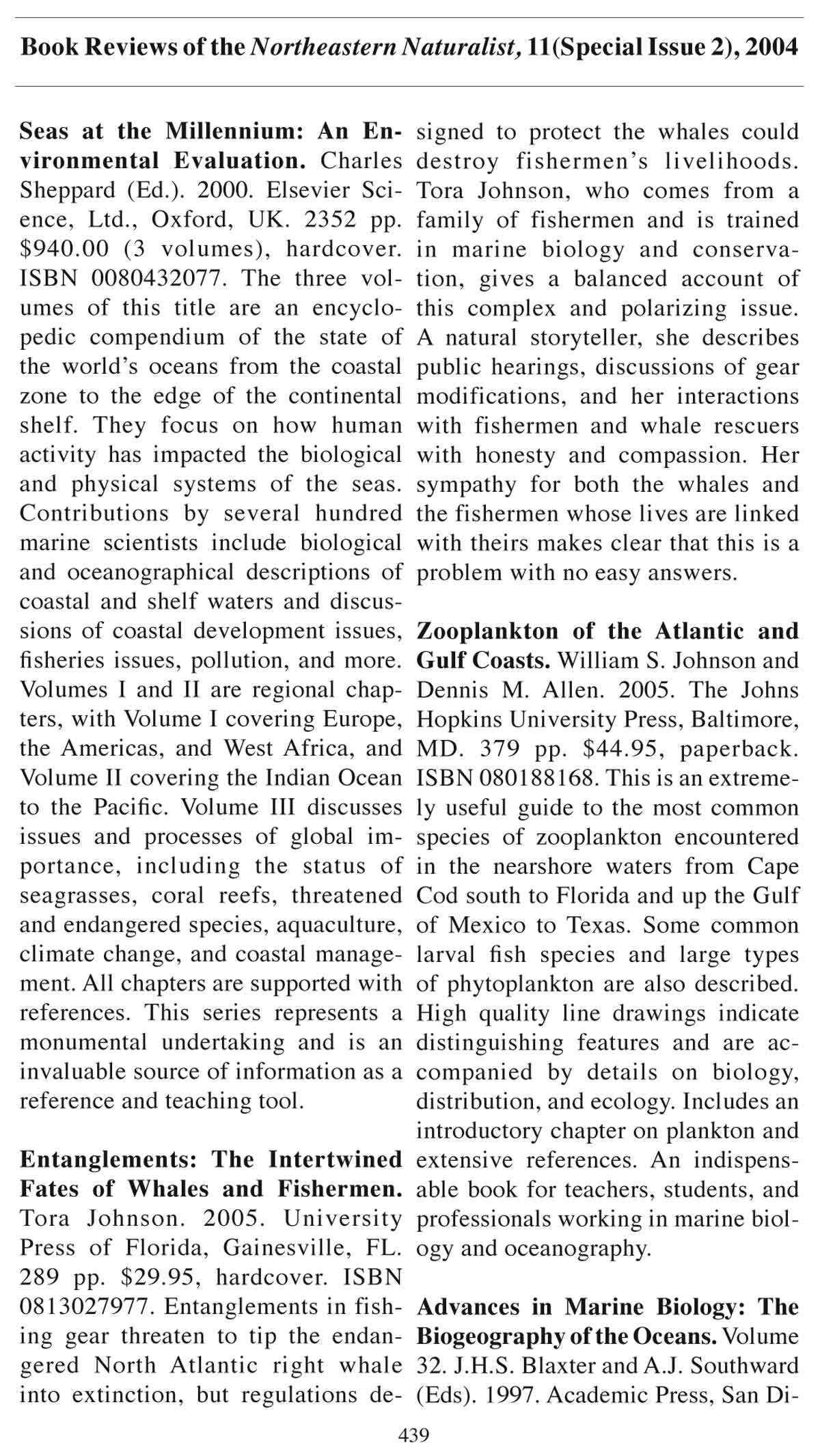Book Reviews
2005 439
Seas at the Millennium: An Environmental
Evaluation. Charles
Sheppard (Ed.). 2000. Elsevier Science,
Ltd., Oxford, UK. 2352 pp.
$940.00 (3 volumes), hardcover.
ISBN 0080432077. The three volumes
of this title are an encyclopedic
compendium of the state of
the world’s oceans from the coastal
zone to the edge of the continental
shelf. They focus on how human
activity has impacted the biological
and physical systems of the seas.
Contributions by several hundred
marine scientists include biological
and oceanographical descriptions of
coastal and shelf waters and discussions
of coastal development issues,
fisheries issues, pollution, and more.
Volumes I and II are regional chapters,
with Volume I covering Europe,
the Americas, and West Africa, and
Volume II covering the Indian Ocean
to the Pacific. Volume III discusses
issues and processes of global importance,
including the status of
seagrasses, coral reefs, threatened
and endangered species, aquaculture,
climate change, and coastal management.
All chapters are supported with
references. This series represents a
monumental undertaking and is an
invaluable source of information as a
reference and teaching tool.
Entanglements: The Intertwined
Fates of Whales and Fishermen.
Tora Johnson. 2005. University
Press of Florida, Gainesville, fl.
289 pp. $29.95, hardcover. ISBN
0813027977. Entanglements in fishing
gear threaten to tip the endangered
North Atlantic right whale
into extinction, but regulations de-
Book Reviews of the Northeastern Naturalist, 11(Special Issue 2), 2004
439
signed to protect the whales could
destroy fishermen’s livelihoods.
Tora Johnson, who comes from a
family of fishermen and is trained
in marine biology and conservation,
gives a balanced account of
this complex and polarizing issue.
A natural storyteller, she describes
public hearings, discussions of gear
modifications, and her interactions
with fishermen and whale rescuers
with honesty and compassion. Her
sympathy for both the whales and
the fishermen whose lives are linked
with theirs makes clear that this is a
problem with no easy answers.
Zooplankton of the Atlantic and
Gulf Coasts. William S. Johnson and
Dennis M. Allen. 2005. The Johns
Hopkins University Press, Baltimore,
MD. 379 pp. $44.95, paperback.
ISBN 080188168. This is an extremely
useful guide to the most common
species of zooplankton encountered
in the nearshore waters from Cape
Cod south to Florida and up the Gulf
of Mexico to Texas. Some common
larval fish species and large types
of phytoplankton are also described.
High quality line drawings indicate
distinguishing features and are accompanied
by details on biology,
distribution, and ecology. Includes an
introductory chapter on plankton and
extensive references. An indispensable
book for teachers, students, and
professionals working in marine biology
and oceanography.
Advances in Marine Biology: The
Biogeography of the Oceans. Volume
32. J.H.S. Blaxter and A.J. Southward
(Eds). 1997. Academic Press, San Di440
Northeastern Naturalist Vol. 11, Special Issue 2
ego, CA. 596 pp. $159.95, hardcover.
ISBN 0120261324. Russian biologists
of the former USSR undertook
marine research in all parts of the
world’s oceans on well equipped vessels.
This volume highlights some of
their contributions to the study of the
geographical and vertical distribution
of life in the oceans, including descriptions
of life at great depths. The
contributions range from the study of
plankton and squid to descriptions of
life on ocean ridges and hydrothermal
vents. This is a scholarly and technical
work bringing Russian thinking about
the biogeography of the oceans to a
wider audience.
Zooplankton Methodology Manual.
R.P. Harris, P.H. Wiebe, J. Lenz, H.R.
Skjoldal, and M. Huntley (Eds). 2000.
Elsevier Academic Press, London,
UK. 684 pp. $151.95, hardcover.
ISBN 0123276454. The study of
zooplankton, the microscopic assemblage
of animals that drift in the
world’s oceans and form the basis of
the marine food chain, is essential to
any understanding of oceanography
or marine biology. This manual is
authored by experts selected from the
International Council for the Exploration
of the Sea and other specialists.
The chapters in this volume present
the most up-to-date information on
sampling and collecting zooplankton,
techniques for assessing biomass
(including new optical and acoustical
methods), population genetics, and
modeling of zooplankton dynamics.
This is a highly technical and scientific text that should prove to be invaluable
to marine research scientists
and graduates. Well referenced to the
scientific literature.
Whales and Dolphins of the
World. Mark Simmonds. 2004.
The MIT Press, Cambridge, MA.
160 pp. $29.95, hardcover. ISBN
0262195194. Fantastically illustrated
with 180 color photographs of
whales and dolphins in their natural
settings. The chapters provide an
introduction to their biology, diversity,
life histories, and interactions
with humans. Accessible to a broad
audience. An informative and visual
introduction to these fascinating and
appealing marine mammals!
Ocean Circulation and Climate:
Observing and Modeling the
Global Ocean. Gerold Siedler,
John Church, and John Gould (Eds).
2001. Academic Press, London, UK.
715 pp. $104.95, hardcover. ISBN
0126413517. This volume is a synthesis
of the major findings of the
World Ocean Circulation Experiment,
a project of the World Climate
Research Programme. Unprecedented
in scope and precision, the data
presented here provides a basis for
developing oceanic and atmospheric
circulation models used to explain
and forecast global climate change.
Accompanied by charts, tables, and
graphs, and well referenced to the
scientific literature. Oceanographers,
meteorologists, and climate scientists
will find this book to be of particular
value.
Reviewed by Stephen Eddy













 The Northeastern Naturalist is a peer-reviewed journal that covers all aspects of natural history within northeastern North America. We welcome research articles, summary review papers, and observational notes.
The Northeastern Naturalist is a peer-reviewed journal that covers all aspects of natural history within northeastern North America. We welcome research articles, summary review papers, and observational notes.